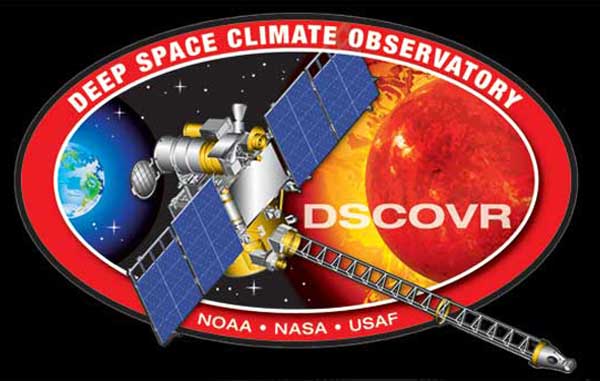
Conceived in a dream by a former Vice President of the United States, hamstrung by a rapidly increasing price tag, disparagingly nicknamed “a multi-million-dollar screen saver,” grounded in the wake of a steadily shrinking shuttle flight schedule and the Columbia disaster and finally revived and given a new name as part of a collaborative effort between NASA and the National Oceanic and Atmospheric Administration (NOAA), the Deep Space Climate Observatory (DSCOVR) is ready to be launched into space at 6:10 p.m. EST on Sunday, 8 February. It will be lofted atop a SpaceX Falcon 9 v1.1 booster from Space Launch Complex (SLC)-40 at Cape Canaveral Air Force Station, Fla., and will eventually be positioned at the L1 Lagrange Point, some 930,000 miles (1.5 million km) away, where the gravitational influences of Earth and the Sun meet in equilibrium. Although SpaceX has previously launched missions into low-Earth orbit and into geostationary transfer orbit, DSCOVR will mark the first occasion that the Hawthorne, Calif.-based company has delivered a payload so far into space.
Originally scheduled to fly on 31 January, the launch slipped by more than a week until the present No Earlier Than (NET) date of 8 February. Sources at SpaceX informed AmericaSpace that the delay was partly due to the fact that DSCOVR is the company’s first mission in conjunction with the U.S. Air Force, who had requested more third-party liability insurance than ordinarily required for a commercial mission. This required SpaceX senior executives to take additional time to “herd the underwriter cats” and led to a slight delay. If SpaceX is unable to meet Sunday’s opening launch attempt, it has Eastern Range approval for a backup opportunity at 6:07 p.m. on Monday.
Yet the mission which today bears the name “DSCOVR” is not a new one. It was originally conceived in a February 1998 dream by Vice President Al Gore, during his tenure under the Clinton Administration. He challenged NASA to build a relatively inexpensive 330-pound (150-kg) satellite, costing as little as $20 million and no more than $50 million, and deploy it from the shuttle no later than 2000 for eventual emplacement at the L1 Earth-Sun location, to broadcast real-time views of the Home Planet over the internet, every 15 minutes, by means of a high-definition television camera and 8-inch (20 cm) integrated telescope. In a March 1998 speech, Gore formally introduced the mission and named it “Triana,” honoring Rodrigo de Triana, the Spanish lookout aboard Christopher Columbus’ ship, La Pinta, who first sighted the New World on 12 October 1492. Gore hoped that the involvement of university students, industry and government would serve to inspire and educate a new generation of scientists, explorers and engineers. NASA Administrator Dan Goldin agreed with this “exciting challenge,” describing Triana’s overarching potential as “important to inspire young minds, provide new perspectives on the planet for our scientific community and perhaps provide commercial applications as well.”
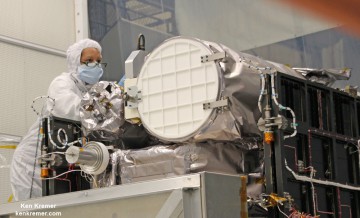
In July 1998, NASA solicited proposals for research instruments aboard the satellite, which would primarily be focused upon solar physics and climate science. Three months later, after scientific and technical peer reviews, the agency selected a pair of instruments—the 10-filtered Earth Polychromatic Imaging Camera (EPIC), to be built by Lockheed Martin, and the National Institute of Standards Advanced Radiometer (NISTAR)—for inclusion aboard Triana. Both had been proposed by the Scripps Institution of Oceanography at the University of California at San Diego, with Dr. Francisco Valero appointed to serve as principal investigator.
“An advanced radiometer at L1 will provide, by looking at the whole sunlit side of the Earth at once, the first direct measurements of the radiant power reflected by the planet and thereby contribute to our knowledge of how much of the Sun’s energy is absorbed by the atmosphere,” explained Dr. Valero. Monitoring the Home Planet’s albedo from L1 distance promised to be challenging, but offered the equivalent of having a thermometer to observe the entire Earth in one perspective. “The EPIC instrument will observe the Earth’s vegetation canopy structure and evolution by taking advantage of the retro-reflectance, or ‘hot spot,’ view that will be available by being in-line between the Earth and the Sun. The EPIC also will observe clouds and aerosols.”
However, even at this early stage in its development—and with NASA’s Goddard Space Flight Center (GSFC) of Greenbelt, Md., having allocated a Small Explorer (SMEX)-Lite spacecraft and ground system—the cost of Triana had expanded to $77 million, thanks in part to decisions to add an ultraviolet capability for EPIC and a plasma magnetometer to study magnetic fields and the solar wind. The weight of the instruments also increased, with EPIC peaking at 132 pounds (60 kg), about 75 percent more than the original Scripps proposal. In response to this and other increases, NASA reallocated $35 million of its Fiscal Year 1999 funds from other Earth Science programs into the satellite and by July 1999 the Triana team had either spent or obligated $24.7 million of this.
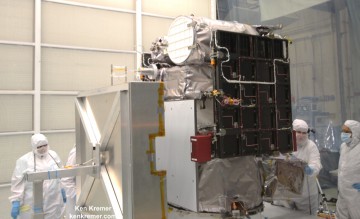
This underestimation of cost came as little surprise to many within NASA. Shortly after Triana’s conception, the Jet Propulsion Laboratory (JPL) of Pasadena, Calif., reviewed a GSFC feasibility analysis and estimated that the mission would reach $96.5 million, excluding launch, outreach, additional scientific experiments or science team personnel, whilst the Langley Research Center (LaRC) of Hampton, Va., predicted that building the spacecraft alone would reach $52 million. Moreover, this latter figure also did not include the costs of Triana’s launch, an upper stage to deliver it to L1 and orbital operations.
In September 1999, a report from the office of NASA Inspector-General Roberta Gross harshly criticized the satellite’s scientific potential, noting that the agency “should reassess … its current approach to the mission.” In its analysis, it was explained that “a relatively simple and inexpensive mission focused primarily on inspiration and education has evolved into a more complex mission focused primarily on science,” which, although beneficial in terms of research output, were detrimental in terms of overall cost. “We are also concerned that the Triana spacecraft, originally conceived as a co-operative effort between university students, industry and government, is essentially being built, launched and operated by NASA,” the Inspector-General’s office reported, before making three recommendations for further progress. Triana could be launched atop a commercial booster and have its scientific potential maximized to bring it into alignment with the goals of the Commercial Space Act, or it could be rescoped in terms of removing instruments or changing its orbit to reduce its overall cost, or it could be replaced by a “Virtual Triana” mission, using data gathered from other spacecraft already aloft at the time.
The cost of launching aboard the shuttle posed further headaches. An initial Request for Flight Assignment had been submitted in November 1998, stating that Triana would be launched into low-Earth orbit “as a secondary payload.” Based upon the SMEX-Lite spacecraft—which was designed to fly atop an expendable booster—Triana would need to meet shuttle-specific safety requirements, be adaptable to its unique launch environment and feature an Italian Research Interim Stage (IRIS) booster to deliver it from the payload bay onto a trajectory to L1. Further, the satellite’s estimated weight had ballooned to 9,400 pounds (4,260 kg), which represented about a fifth of the shuttle’s payload capacity and provided an approximate launch cost in the range from $17 million to $87 million. With a shuttle launch earmarked for STS-107 in September 2000, the risk of substantive delays raised the distinct possibility that still greater levels of funding would be required. In its concluding remarks, the Inspector-General’s office anticipated that the total cost of Triana might extend from a low end of $144 million to as high as $220 million.
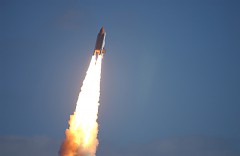
Nevertheless, a National Research Council (NRC) study, published in March 2000, proved more sympathetic to Triana and found that it would “complement and enhance data from other missions because of the unique character of the measurements obtainable at the L1 point in space.” It was also stressed that the program’s cost was “not out of line for a relatively small mission that explores a new Earth observing perspective and provides unique data.” As circumstances transpired, the NRC’s positive outlook provided enough impetus for Triana to be completed in the fall of 2000, at a total cost of $150 million. Although significantly higher than early estimates, it was also just a tenth of the cost of the 1995-launched Solar and Heliospheric Observatory (SOHO). “NASA was not used to doing things either quickly or cheaply in those days,” explained Ghassem Asrar, the Associate Administrator for Earth Science at NASA Headquarters in Washington, D.C. “This program was a breakthrough.”
However, with STS-107 delayed until no sooner than August 2001, it became clear that there would be no place for Triana. When the payload crew of this ultimately ill-fated mission was announced in September 2000 and the orbiter crew the following December, reference was made to “scientific research for the U.S. and its international partners,” but nothing about Vice President Al Gore’s pet project. Following the arrival of the Bush Administration in January 2001—and with a reduced flight schedule dominated by International Space Station (ISS) construction and maintenance—Triana was removed from the shuttle manifest and the program was suspended. The spacecraft was placed into “Stable Suspension” storage in an environmentally controlled clean room in Building 29 at GSFC in November 2001, until such time as a new mission might materialize.
Shortly after the loss of Columbia, in anticipation of a future and somewhat different mission, Triana received its current name of DSCOVR. A “Restart Study” was completed by GSFC in June 2007 and the following year NOAA initiated a $500,000 contract with NASA to remove the satellite from storage and subject it to testing, including an “Aliveness Test.” Later that same year, the Committee on Space Environmental Sensor Mitigation Options performed an assessment, as requested by the White House Office of Science and Technology Policy, which determined that DSCOVR was an optimal solution for the space weather forecasting requirements of both NOAA and the U.S. Air Force. As a result, NOAA entered a further contract with NASA in 2009-2011—which totaled $6.3 million—to refurbish the spacecraft and recalibrate its space weather instruments. In the fall of 2011, NOAA received $31.1 million for Fiscal Year 2012 in support of DSCOVR and the Air Force was appropriated $134.5 million for the launch vehicle. In December 2012, SpaceX’s Falcon 9 booster was selected to deliver DSCOVR into space.
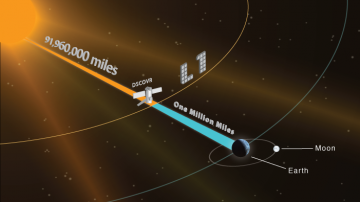
As it steadily progressed from years in the clean room and onto the road towards launch, the DSCOVR mission officially began anew under GSFC’s Reimbursable Projects Program (RPP) in October 2011 and Albert Vernacchio was named Project Manager the following January. A few weeks later, NASA briefing materials described it as a spacecraft whose principal focus would “continue solar wind measurements in support of space weather requirements, providing three-dimensional distribution function of the proton and alpha components of the solar wind, three-dimensional magnetic-field vector and three-dimensional electron velocity distribution.” Harking back to its original mandate in Vice President Al Gore’s dream, a secondary objective for DSCOVR was “to observe the Earth from the unique Earth-Sun L1 perspective.”
Sensors were delivered to the spacecraft in 2013 and environmental testing was undertaken at GSFC through the following year. Of particular significance, in November 2014, was the completion of the Pre-Ship Review and Operational Readiness Review, which respectively confirmed that DSCOVR’s hardware and software was ready for transportation to Cape Canaveral Air Force Station and that its ground system readiness, flight concept of operations, project management, operations and sustainability, safety and mission assurance, system design, technical management and training were satisfactory. On 25 November, the spacecraft was transported by truck to Building 2 at the Astrotech payload processing facility in Titusville, Fla., for final preparations.
A glance at the spacecraft bus bears more than a passing resemblance to the instrumentation originally earmarked for Triana. DSCOVR weighs about 1,250 pounds (570 kg) and will derive electrical power from a pair of deployable solar arrays and batteries. It has an anticipated operational lifetime of at least two years. Its 12-inch (30-cm) EPIC will view the entire sunlit Earth from sunrise through sunset, providing a unique angular perspective for applications which include ozone and aerosol monitoring, cloud height measurements, vegetation observations and ultraviolet reflectivity. Moreover, EPIC’s data will final other uses, such as dust and volcanic ash maps across the entire planet. “As part of EPIC data-processing,” it was explained, “a full-disk, true-color Earth image will be produced about every two hours. This information will be publicly available through NASA Langley Research Center, approximately 24 hours after the images are acquired.” Also aboard DSCOVR is the NISTAR instrument, which is tasked with measuring reflected and emitted energy in the range of 0.2-100 microns from Earth’s entire sunlit face, as part of efforts to better understand human and natural impacts on our planet’s radiation budget.
DSCOVR also carries a Plasma Magnetometer (PLASMAG), which will provide highly accurate and rapid warnings of geomagnetic storms, with lead times of up to one hour. It will measure the magnetic field and the velocity distribution functions of the electron, proton and alpha particles of the solar wind at much higher resolutions than previously possible. An Electron Spectrometer (ES) will provide high-temporal-resolution observations of the solar wind an a Pulse Height Analyzer (PHA) will undertake real-time measurements of particle events which might affect DSCOVR’s electronics.
The second part of this article, detailing the SpaceX Falcon 9 v1.1 mission to deliver DSCOVR into space, will appear tomorrow.
Want to keep up-to-date with all things space? Be sure to “Like” AmericaSpace on Facebook and follow us on Twitter: @AmericaSpace
Missions » DSCOVR »




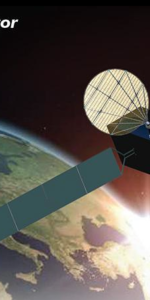
Excellent! GodSpeed DSCOVR. Every sat has her day!
Too bad Al Gore is not strapped to the side of the rocket………
Too bad this site doesn’t have a like button. How about harry Reed on the other side for balance.
I wish that it had stayed more true to its original purpose”broadcast real-time views of the Home Planet over the internet, every 15 minutes, by means of a high-definition television camera and 8-inch (20 cm) integrated telescope”. Science was a secondary purpose. It’s when we want all those “bells and whistles” that costs go up.
To be fair, since the original plans, ISS gained several HD cameras. They may not be full-planet views, but they’re still live and impressive.